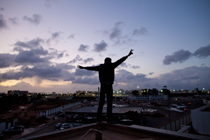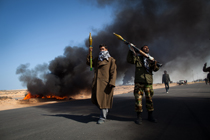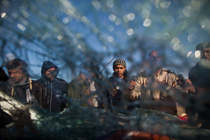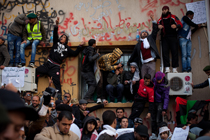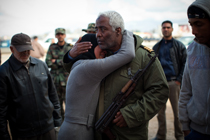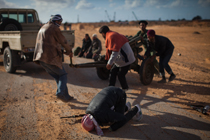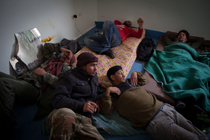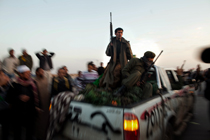 |
 |
||||||||||||||
| features War and Anarchy Contagion Good Vibes in L.A. The New Girl Order think tankplanet tufts newswire the big day departments |

War and Anarchy
In the heart of Libya's ragtag rebellionWhen revolution sparked in Libya this past February, I spent a month in the eastern part of the country as the correspondent for GlobalPost, the Boston-based international news site. I had come to cover the latest of the uprisings spreading across the Arab world, but the deadly confrontations that followed cast a shadow over the idealism inspired by the revolts in Egypt and Tunisia.
Arriving a week after the demonstrations began, I found Benghazi in a state of frenetic animation. A people eager to show off how they had ousted Gaddafi’s forces from the city gave the foreign media an effusive welcome. Families toured the wreckage of the once feared Katiba military barracks. Young men in mismatched military garb directed traffic. Ecstatic daily demonstrations filled the streets, and everywhere people sang, chanted, and prayed. One day, I was photographing a military training exercise at a local school when a shouting match broke out among the rebels. “They say their brothers are dying down in Brega,” a translator told us, referring to the strategic oil town four hours away. “They don’t want to train anymore—they want to fight.” Seconds later, the neat lines formed by the drill instructors dissolved as the men spewed out from the school, pulling themselves into nearby trucks and racing toward Brega. I didn’t know it yet, but the war had begun.
I followed the group known, vaguely, as “the rebels.” They were a ragtag assortment of students, shopkeepers, and merchants who had rushed in to help the revolution. They came from different tribes, different regions, and different social classes. Some were experienced soldiers; most were not.
Dashing in on the heels of Tunisia’s and Egypt’s relatively bloodless revolutions, I had arrived in Libya unprepared for what would devolve into one of the most volatile of the uprisings to shake the Arab world. I didn’t have the body armor or helmet I had worn in past conflicts. More to the point, though, I had never seen war like this. There were no boundaries imposed by a media-savvy military like in Afghanistan.
This war felt anarchic. The line of control wavered over those weeks between the Mediterranean cities of Ajdabiya, Brega, Ras Lanuf, and Bin Jawad. As I crouched amidst the rebels in the brush and desert, the crack of nearby shelling alternated with the deafening explosions of bombs dropped by government jets. Young men who had never shouldered a gun before tried desperately to be brave, aware that the rifles they held were little more than amulets against mortars and artillery. The dead and injured were carried off in ambulances driven by volunteers. Optimism gave way to a bitter reality, and the rebels began to ask, not when, but if Gaddafi was going to fall.
The fighting took a toll not only on its combatants, but on civilians—large numbers of whom were killed or forced to flee—and on my friends and colleagues covering the story. People close to me were captured, detained, and abused by pro-Gaddafi soldiers, while others paid with their lives. Although the rebels’ flag now flies in Tripoli, no one knows what will emerge in this new Libya, or to what end those tens of thousands of people died. That uncertainty leaves an open chapter in my own life, too.
Nichole Sobecki, A08, is a freelance writer and photographer based in Nairobi. Her coverage of news, culture, conflict, and economics in the greater Middle East and Africa has been featured in the New York Times, the Wall Street Journal, the Guardian, and GlobalPost.
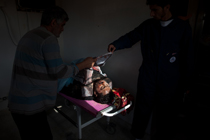
Friends cover the face of Mohammad Abdul Salam at the morgue of the hospital in Brega. Salam, a rebel, was killed in fighting with Gaddafi loyalists. |
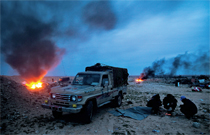
Rebel fighters make tea at the Brega checkpoint beside burning tires that had been lit by the fighters to provide cover from air strikes. |
